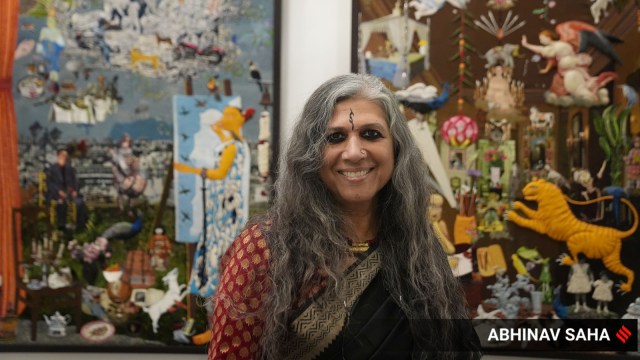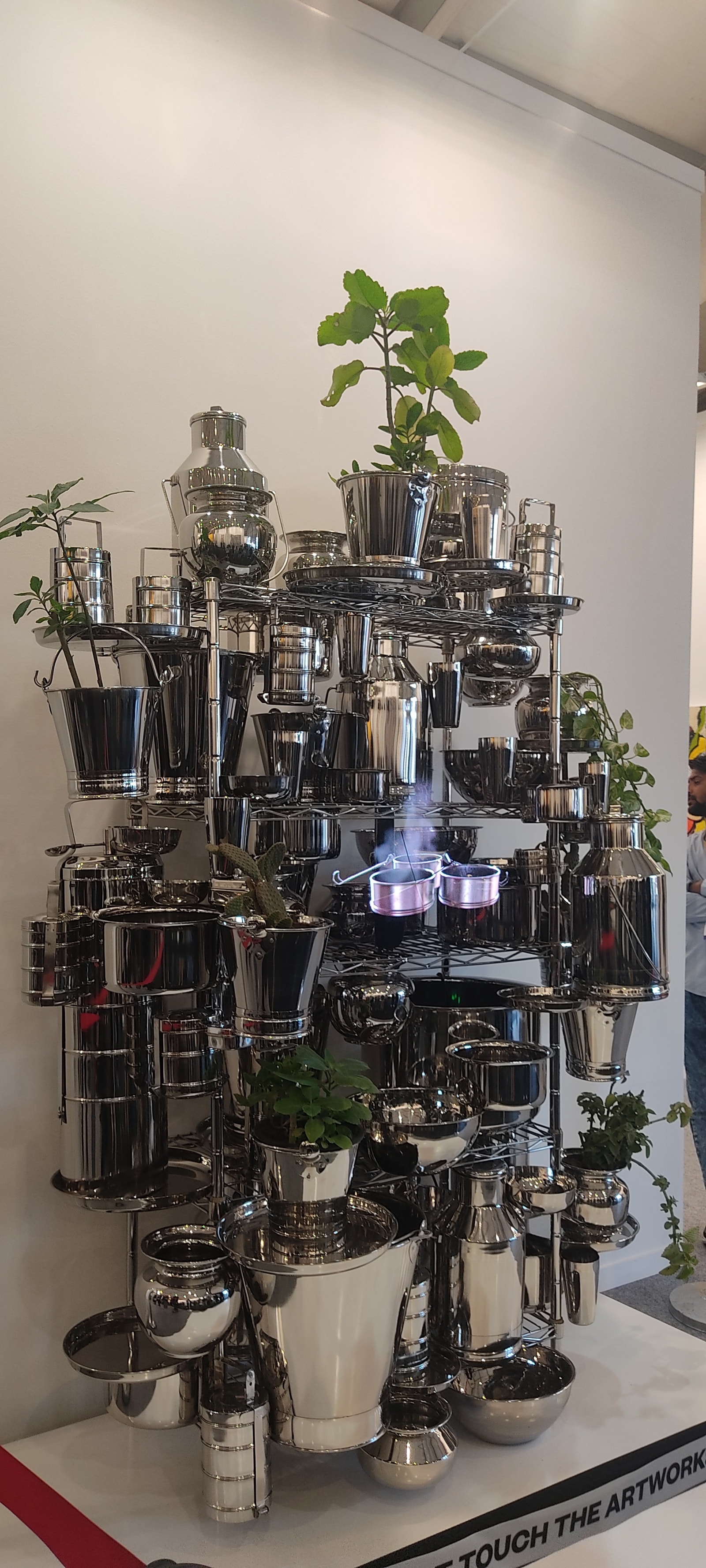📣 For more lifestyle news, click here to join our WhatsApp Channel and also follow us on Instagram
India Art Fair 2025: 5 works of art that define the zeitgeist
From monumental canvases to thought-provoking installations, these are the works shaping conversations at IAF this year.
 Rekha Rodwittiya -- Home is wherever you are (Express photo by Abhinav Saha)
Rekha Rodwittiya -- Home is wherever you are (Express photo by Abhinav Saha)Across 120 exhibitors, the India Art Fair (IAF) is not just about preserving artistic legacies but about pushing them forward. Here, legendary masters share space with contemporary disruptors, and the lines between folk art, craft, and modern expression blur into something refreshingly new.
This year’s edition presents a diverse spectrum, spanning centuries of Indian art while embracing global influences. From thought-provoking installations to monumental canvases, the fair showcases works that challenge perceptions, reimagine the ordinary, and celebrate the evolving language of art. Here are five standout works capturing attention this year:
Subodh Gupta’ — Mars Kitchen at Nature Morte
Renowned for transforming everyday kitchen utensils into striking works of art, Subodh Gupta once again plays with familiar forms in “Mars Kitchen”. Here, he envisions a futuristic kitchen where stainless steel utensils “glisten like artifacts from a distant future, their cold precision contrasted.” The piece reimagines the ordinary as extraordinary, inviting viewers to consider how even the most familiar objects hold transformative potential.
A note accompanying the work reads: “At its core, Mars Kitchen is a reflection of everyday rituals, transmuted into something otherworldly.”
 Subodh Gupta’s Mars Kitchen at Nature Morte (Photo: Vandana Kalra)
Subodh Gupta’s Mars Kitchen at Nature Morte (Photo: Vandana Kalra)
Manu Parekh — Manthan
Measuring an expansive 6.5 x 42 feet, Manthan is the largest canvas Manu Parekh has ever painted. Inspired by Banaras—a city he has felt deeply connected to since his first visit in 1980—the work bursts with floral imagery, symbolising the timeless cycle of “joy and sorrow, beauty and loss, devotion and celebration.”
 Manu Parekh’s Manthan (Photo: India Art Fair)
Manu Parekh’s Manthan (Photo: India Art Fair)
Also reflecting on abstraction with Indian elements, Parekh observed how the country is a microcosm of diverse faiths, each deeply woven into its fabric. “Few artists have denoted abstraction with Indian elements, and this is my attempt,” he said.
Rekha Rodwittiya — Home is wherever you are at Sakshi Gallery
Rodwittiya, known for her explorations of gender, identity, and social narratives, presents two striking embroidered works at the fair. These pieces continue her long-standing engagement with craft and folk practices, an interest shaped by mentors like K G Subramanyan and Jyoti Bhatt, who introduced her to India’s rich traditions of embroidery and textiles.
Discussing the collaboration with Milaaya Embroideries, Rodwittiya said: “This project allowed me to work within the structured language of skilled artisans,who Gayatri Khanna brought together under one roof.”
Reflecting how she has previously worked with the medium, Rodwittiya said, ” In 2007, I did two large Toran textile works titled ‘Home & away’ with the assistance of Archana Shah of Bandhej, for a show in London. In 2010, I incorporated my grandmother’s brocade waistcoat in a series of watercolour paintings along with popular stickers, titled ‘Letters to the universe –– when the sun and the moon fall asleep, only then can I dance naked’.”
NS Harsha — Sprouting Philosopher at Chemould Prescott Road
Mysore-based artist N S Harsha, who won the Artes Mundi Prize in 2008, revisited his signature motif of the contemplative monkey in his 2025 bronze sculpture Sprouting Philosopher.
 NS Harsha — Sprouting Philosopher at Chemould Prescott Road (Photo: Vandana Kalra)
NS Harsha — Sprouting Philosopher at Chemould Prescott Road (Photo: Vandana Kalra)
Emerging from a globe-shaped base imprinted with human footprints, the monkey symbolises the evolution of human thought and philosophy. Accompanying the work, Harsha said: “Throughout history, humans have adapted to changing times by developing new ways of life. Many philosophies have flourished, been challenged, and faded. Sprouting Philosopher is my exploration of this process—the constant emergence of new ideas.”
Atul Dodiya — Weeping Ancestors at Vadehra Art Gallery
Atul Dodiya’s latest work, Weeping Ancestors, is painted on mechanically operated shop shutters—continuing his exploration of the intersection between personal and public histories. The layered composition recalls the aftermath of the 1990s Mumbai riots, where shuttered shops symbolised silence and suppression.
 Atul Dodiya — Weeping Ancestors at Vadehra Art Gallery (Photo: Vandana Kalra)
Atul Dodiya — Weeping Ancestors at Vadehra Art Gallery (Photo: Vandana Kalra)
His protagonists—historical figures such as Nana Fadnavis, Raja Ram Mohan Roy, and Bahadur Shah Zafar—are depicted in tears, mourning the present. A note alongside the work explains: “His iconic painted shutters engage with questions of security, access and repression, a series that grows out of the ’90s riots in Mumbai, resulting in pervasive shutdown of life and navigation in an otherwise bustling city. To Dodiya, the repeated visuals of closed-down shop shutters served as an emotional affront, as misgivings of power and progress, concealing yet revealing the historical regrets an urban landscape holds underneath its daily grind.”
📣 For more lifestyle news, click here to join our WhatsApp Channel and also follow us on Instagram








- 01
- 02
- 03
- 04
- 05



















